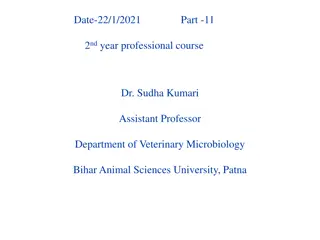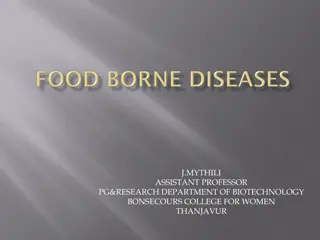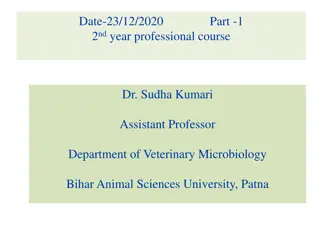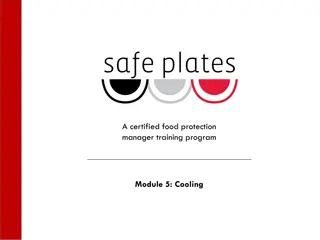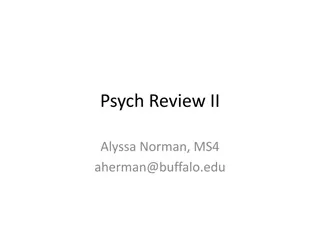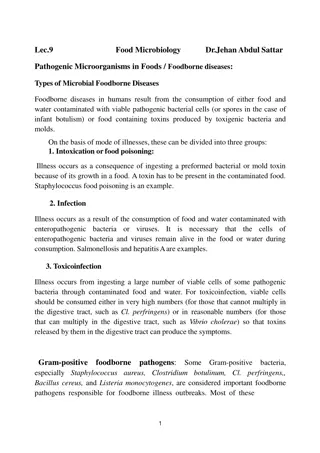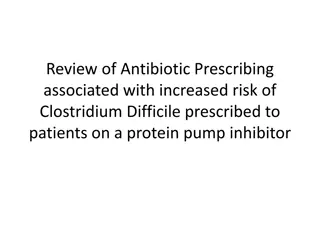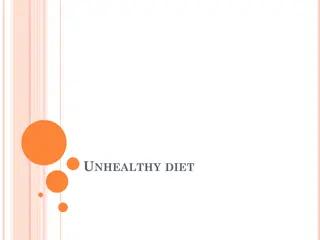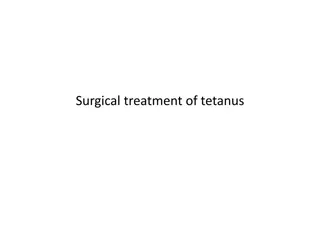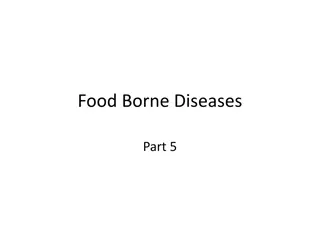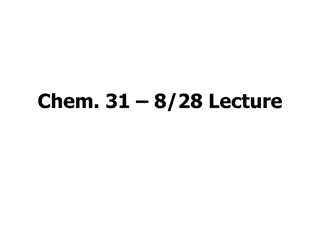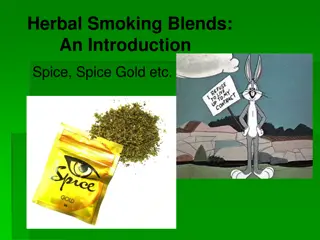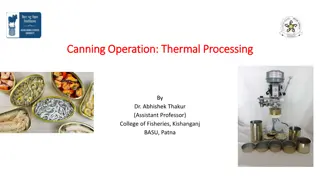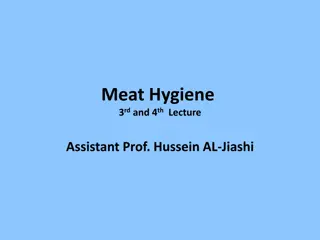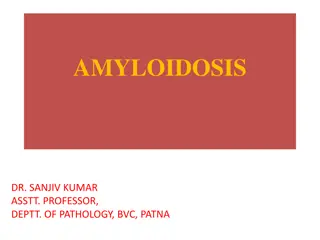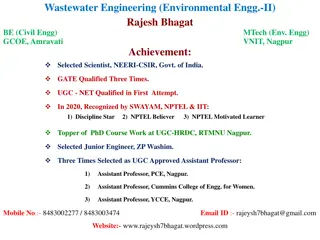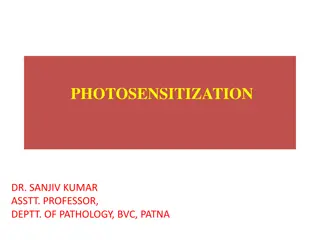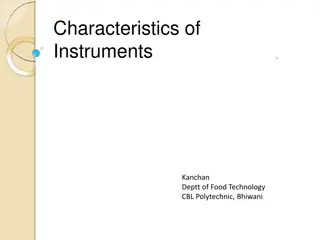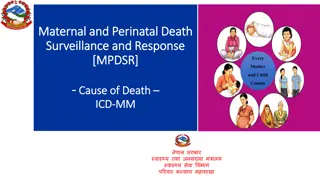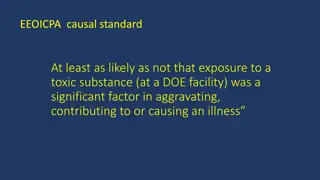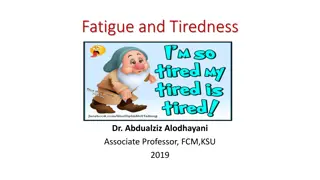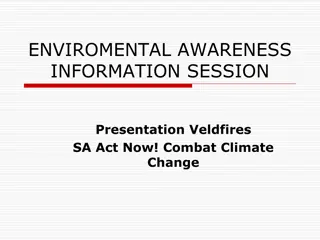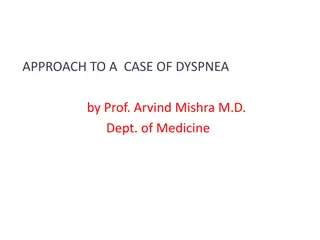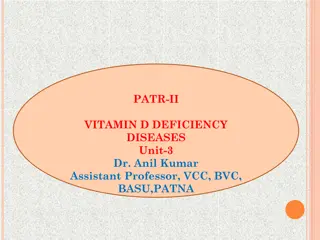Understanding Clostridium Perfringens Intoxication: Causes and Characteristics
Clostridium perfringens intoxication is a foodborne illness caused by the ingestion of food contaminated with enterotoxigenic strains of C. perfringens, leading to the production of Clostridium perfringens enterotoxin (CPE). This article discusses the characteristics of CPE, the origins of the organism, its resistance to heat, and the types of foods commonly involved in outbreaks. Proper cooking and hygiene practices are essential to prevent this type of food poisoning.
Download Presentation

Please find below an Image/Link to download the presentation.
The content on the website is provided AS IS for your information and personal use only. It may not be sold, licensed, or shared on other websites without obtaining consent from the author. Download presentation by click this link. If you encounter any issues during the download, it is possible that the publisher has removed the file from their server.
E N D
Presentation Transcript
Food Borne Diseases Part4
Clostridium perfringens intoxication This is a food borne intoxication caused by Clostridium perfringens enterotoxin (CPE) produced in the gastrointestinal tract by enterotoxigenic strains of C. perfringens. The organism is found in the soil, dust, water, sewage marine sediments, decaying materials, intestinal tracts of humans and other animals. This organism is a spore-forming, anaerobic, gram positive bacillus.
Clostridium perfringens intoxication Food poisoning strains have a variety of origins including human and animal feces, sewage and flies. Spores produced by these organisms can resist boiling for 4 or more hours. If the spores are present as contaminants on raw meat they may resist boiling or steaming, and on slow cooling the spores will germinate into rapidly multiplying bacterial cells, which produce large amounts of toxin.
Cause of intoxication Clostridium food borne intoxication is caused by the ingestion of food containing large numbers of vegetative cells of enterotoxigenic C. perfringens type A and some type C and D strains. These cells multiply in the intestine and sporulate releasing Clostridium perfringens enterotoxin (CPE). Sometimes CPE may be pre-formed in food, and once the food is consumed, symptoms may occur within 1-2 hours.
Characteristics of CPE Clostridium perfringens enterotoxin (CPE) is synthesized during sporulation. CPE is heat labile (destroyed at 60oC for 10 min) and its activity is enhanced by trypsin. Note: The food poisoning strains are heat resistant and survive heating at 100oC for 1 hr).
Vehicle foods The food involved are those that are prepared one day and served the next day. Foods that have been involved include red meats, chickens, fish, pork, fruits, vegetables, spices etc. The heating of such foods is inadequate to destroy heat resistant endospores, Upon cooling and warming the endospores germinate and grow.
Vehicle foods Cooking kills the vegetables cells of Cl. perfringens but activates surviving spores, which will germinate and multiply. Foods poisoning occurs when the level reaches 107-108cells/g of food, Growth is enhanced by anaerobic conditions achieved after removal of oxygen by cooking.,
Mode of transmission to foods 1. Directly from slaughter animals 2. Contamination of slaughter meat from containers, handlers, dust, and water. 3. Cross -contamination in the kitchen environment.
Symptoms of disease in man Symptoms appear 6-24 hours after ingestion of a large number of viable vegetative cells up to 5x108/g food, but not after ingestion of spores. Symptoms include nausea, intestinal cramps, pronounced diarrhea, Vomiting is rare and the illness takes a duration of 1-2 days.
Diagnosis 1. Use of clinical signs. Typical symptoms (abdominal pain and profuse diarrhea), 12-24 hrs following consumption of food. Enumeration of C. perfringens in foods and stool (counts of 105cfu/g of food) Detection of enterotoxin in food and patient stool using serological methods e.g. ELISA, RPLA etc. 2. 3.
Prevention 1. Proper cooking of food and eating freshly prepared foods. 2. Thorough washing and sanitation of containers 3. Hygiene handling of cooked food 4. Fast cooling of cooked food. Storing food in small quantities will enhance cooling. 5. Proper reheating of cold cooked food before consumption 6. Storage of leftovers or unused foods in freezers
Clostridium botulinum foodborne Intoxication Clostridium botulinum food borne intoxication (botulism) is a type of food poisoning caused by consumption of enterotoxins produced by strains of Clostridium botulinum. C. botulinum is an obligate, spore-forming anaerobe, and Gram positive bacilli The strains are divided into proteolytic and non-proteolytic types according to whether they hydrolyze proteins or not.
The intoxication is caused by botulinal toxins A, B, E, F and G, produced by C. botulinum type A, B, E, F and G, while the organism grows in food. C. botulinum types C and D produce toxins C and D that cause disease in animals Type E strains are non-proteolytic while the rest are proteolytic. Spores of C. botulinum type A can survive temperatures of 120oC.
Growth characteristics Proteolytic strains grow at temperature range between 10-50oC, while non-proteolytic grow at 3.3-45oC (optimum 35-37oC). Toxin production occurs at temperature range between 25-30oC. Both strains grow at minimum pH of 4.5. Proteolytic strains produce an active botulinal toxin, while non-proteolyic strains produce inactive pro-toxin that require activation by trypsin.
Characteristic of Botulinal toxins These toxins are neurotoxins, that are highly toxic, heat labile (inactivated by heating at 80oc for 10 min), unstable at alkaline pH (but stable below pH 7.0) but resistant to pepsin and acidic environment. The toxins can resist the action of the gastric and intestinal juices. Botulinus toxin is one of the most lethal poisons known. The calculated lethal dose for an adult person is 10 g.
Types of foods implicated Foods associated with anaerobic conditions such as spoiled canned meat, or hams and bacon stacked without air access, are particularly liable to be infective. Home made fermented foods have been incriminated, together with smoked, pickled and canned foods that are allowed to stand and then eaten without adequate cooking. Uncooked fresh foods are safe because they are eaten before the toxin has had time to develop, while, if foods are cooked, the toxin is destroyed.
Role of preservatives in meat Nirates/nitrites are used in canned meat as preservatives. The salts reduce chances of growth of C. botulinun and inhibit toxin production. The danger of botulism has been the deciding factor in the formulation of food processing techniques, especially canned meat .
Mode of transmission 1. Contamination of food due to improper handling. 2. Insufficient heating of food to destroy spores. 3. Spores present in animal tissues e.g. meat and fish.
Symptoms of the disease in man Adult botulism The period of incubation in man is usually 12-72 hrs). Symptoms include nausea, vomiting, fatigue, dizziness, headache, dryness of skin, mouth and throat, constipation, lack of fever, nerve paralysis and great muscular weakness, double vision, respiratory failure and death. Duration of illness 1-10 days and mortality is high up to 60-100% of affected persons. The earlier the appearance of symptoms, the higher the mortality rate.
Infant botulism Occurs in infants less than 1 year of age following ingestion of spores in honey and syrup. The spores germinate in the gastrointestinal tract with toxin production. A high number of spores are found in feces of infants during acute phase of the disease. The number reduces as recovery progress. Symptoms are similar to adult botulism
Diagnosis 1. Use of clinical symptoms 2. Isolation of C. botulinium strain from food. 3. Demonstration of botulinal toxins in suspected food, patient serum, vomit and stool using the following methods: i). Biological methods e.g. mouse challenge and protection test ii). Serological methods e.g. diffusion, electrophoresis, ELISA etc
Preventive measures Ensuring proper manufacturing practices e.g. ensure proper sterilization and preservation of canned meat Preserved foods possessing rancid or other odors should be rejected Proper heating of food before consumption to destroy heat labile neurotoxins. Food should be heated to 80oC and temperature maintained for at least 10 min before eating. Picked foods are rendered safe if the brine used contain not less than 10 % common salt, in weaker brines, microorganisms can continue to multiply.
Prevention cont Ensuring fast cooling of food. This will ensure that spores that may be remaining do not germinate in food. Utmost care should be taken in the manufacture of cans, their transport, handling, storage and subsequent use during packaging of product.


